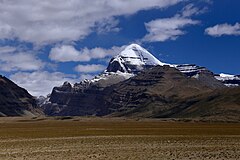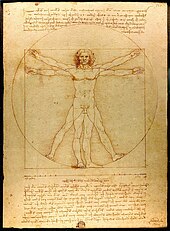Axis mundi
In astronomy, axis mundi is the Latin term for the axis of Earth between the celestial poles.
In a geocentric coordinate system, this is the
In 20th-century comparative mythology, the term axis mundi – also called the cosmic axis, world axis, world pillar, center of the world, or world tree – has been greatly extended to refer to any mythological concept representing "the connection between Heaven and Earth" or the "higher and lower realms".[3] Mircea Eliade introduced the concept in the 1950s.[4] Axis mundi closely relates to the mythological concept of the omphalos (navel) of the world or cosmos.[5][6][7] Items adduced as examples of the axis mundi by comparative mythologists include plants (notably a
Background

There are multiple interpretations about the origin of the concept of the axis mundi. One psychological and sociological interpretation suggests that the symbol originates in a natural and universal psychological perception – i.e., that the particular spot that one occupies stands at "the center of the world". This space serves as a microcosm of order because it is known and settled. Outside the boundaries of the microcosm lie foreign realms that – because they are unfamiliar or not ordered – represent chaos, death, or night.[10] From the center, one may still venture in any of the four cardinal directions, make discoveries, and establish new centers as new realms become known and settled. The name of China — meaning "Middle Nation" (中国 pinyin: Zhōngguó) – is often interpreted as an expression of an ancient perception that the Chinese polity (or group of polities) occupied the center of the world, with other lands lying in various directions relative to it.[8]
A second interpretation suggests that ancient symbols such as the axis mundi lie in a particular philosophical or metaphysical representation of a common and culturally shared philosophical concept, which is that of a natural reflection of the macrocosm (or existence at grand scale) in the microcosm (which consists of either an individual, community, or local environment that shares the same principles and structures as the macrocosm). In this metaphysical representation of the universe, mankind is placed into an existence that serves as a microcosm of the universe or the entire cosmic existence, and who – in order to achieve higher states of existence or liberation into the macrocosm – must gain necessary insights into universal principles that can be represented by his life or environment in the microcosm.[11] In many religious and philosophical traditions around the world, mankind is seen as a sort of bridge between either: two worlds, the earthly and the heavenly (as in Hindu, and Taoist philosophical and theological systems); or three worlds, namely the earthly, heavenly, and the "sub-earthly" or "infra-earthly" (e.g., the underworld, as in the Ancient Greek, Incan, Mayan, and Ancient Egyptian religious systems). Spanning these philosophical systems is the belief that man traverses a sort of axis, or path, which can lead from man's current central position in the intermediate realms into heavenly or sub-earthly realms. Thus, in this view, symbolic representations of a vertical axis represent a path of "ascent" or "descent" into other spiritual or material realms, and often capture a philosophy that considers human life to be a quest in which one develops insights or perfections in order to move beyond this current microcosmic realm and to engage with the grand macrocosmic order.[12]
In other interpretations, an axis mundi is more broadly defined as a place of connection between heavenly and the earthly realms – often a mountain or other elevated site. Tall mountains are often regarded as sacred and some have shrines erected at the summit or base.
As the abstract concept of axis mundi is present in many cultural traditions and religious beliefs, it can be thought to exist in any number of locales at once.
Sacred places can constitute world centers (omphaloi), with an
In the
]
Plants
Plants often serve as images of the axis mundi. The image of the

Human figure
The human body can express the symbol of the world axis.
Homes
Secular structures can also function as axes mundi.[20] In Navajo culture, the hogan acts as a symbolic cosmic center.[29] In some Asian cultures, houses were traditionally laid out in the form of a square oriented toward the four compass directions. A traditional home was oriented toward the sky through feng shui, a system of geomancy, just as a palace would be.[citation needed] Traditional Arab houses are also laid out as a square surrounding a central fountain that evokes a primordial garden paradise. Mircea Eliade noted that "the symbolism of the pillar in [European] peasant houses likewise derives from the 'symbolic field' of the axis mundi. In many archaic dwellings the central pillar does in fact serve as a means of communication with the heavens, with the sky."[30] The nomadic peoples of Mongolia and the Americas more often lived in circular structures. The central pole of the tent still operated as an axis, but a fixed reference to the four compass points was avoided.[31]

Shamanic function
A common
Anyone or anything suspended on the axis between heaven and earth becomes a repository of potential knowledge. A special status accrues to the thing suspended: a
Modern expressions
A modern artistic representation of the axis mundi is the Colonne sans fin (
See also
- Celestial sphere
- Comparative mythology
- History of the center of the Universe
- Hyperborea
- North pole
- Religious cosmology
- Sacred natural site
- Taiji (philosophy)
References
- ^ as a declined form in Latin, plural axes mundorum
- ^ The term is used by Geminus in his Elementa, in early modern editions misattributed to Proclus as Commentarius in sphaeram. R. B. Todd, "The Manuscripts of the Pseudo-Proclan Sphaera", Revue d'histoire des textes 23 (1993), 57–71. The term continues to be used in modern astronomical works throughout the 18th century, e.g., Johann Samuel Traugott Gehler, Physikalisches Wörterbuch (1791), p. 688.
- ISBN 069102068X. p.48–51
- ISBN 069102068X. p.40
- ISBN 0500271259.
- ISBN 0691017778. p.16
- ^ Winther, Rasmus Grønfeldt (2014). "World Navels". Cartouche 89: 15–21.
- ^ ISBN 0140512543. pp.61–63, 173–175
- ^ ISBN 069102068X. p.39
- ISBN 069102068X. p.37–39
- ^ Fritjof Schuon. From the Divine to the Human: Survey of Metaphysics and Epistemology. World Wisdom Books, 1982 p. 23–27.
- ^ Fritjof Schuon. From the Divine to the Human: Survey of Metaphysics and Epistemology. World Wisdom Books, 1982 p. 27–31
- ISBN 069102068X. p.41–43
- ^ Wang, Chong. Lunheng Part I: Philosophical Essays of Wang Ch'ung. Trans. Alfred Forke. London: Luzac & Co., 1907. p. 337.
- ^ Bailey, Gauvin Alexander (2005). Art of Colonial Latin America. New York: Phaidon Press Limited. pp. 21.
- ISBN 0140512543. pp. 680–685
- ISBN 0140512543. pp. 681
- ISBN 978-90-04-13103-3.
- ^ "Noah's ark in the Mountains of Armenia". 11 August 2013.
- ^ ISBN 0691017778. p. 12
- ISBN 0140512543. pp. 148–149
- ISBN 069102068X. p. 52–54
- ISBN 069102068X. pp. 42–45
- ISBN 0500050686.
- ^ ISBN 0140512543. pp. 1025–1033.
- ^ Ogunnaike, Ayodeji (Spring 2019). "The Tree That Centres The World: The Palm Tree As Yoruba Axis Mundi". Africana Studies Review. 6 (1). Southern University at New Orleans: 43–58.
- ISBN 069102068X. p. 54
- ISBN 069102068X. p. 76
- ISBN 978-0-19-960809-6.
- ISBN 0826406181. p. 100.
- ISBN 0140512543. pp. 529–531
- ISBN 0-300-10601-7.
- ISBN 0140512543. pp.b142–145
- ISBN 0826406181. pp. 99-100
33. Wando Bands 2023 Show “Axis Mundi”
